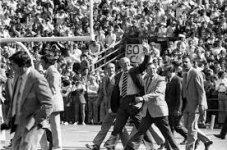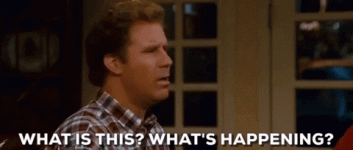With all the hoopla of Trump being in attendance...
- Thread starter PopsCock
- Start date
You are using an out of date browser. It may not display this or other websites correctly.
You should upgrade or use an alternative browser.
You should upgrade or use an alternative browser.
If I were going, I'd probably be there by 4 (or earlier) for a normal Carolina/Clemson game, regardless of which dignitaries were in attendance.What time is everybody planning on arriving at the game. I'm thinking on getting there at about 4ish.
I'd imagine he'd come right before kickoff - so most people shouldn't get caught up in anything. That said, he's got to go well before the end of the game - which I would imagine is the plan. That could be a disaster with the entire stadium trying to leave at once.
I imagine he will make an appearance and leave. Doubt he is interested in the game…only the attention.I'd imagine he'd come right before kickoff - so most people shouldn't get caught up in anything. That said, he's got to go well before the end of the game - which I would imagine is the plan. That could be a disaster with the entire stadium trying to leave at once.
Wrong again. He's going to coach for tCarolina, win the game then win in 2024. Get in loser we're going winning.I imagine he will make an appearance and leave. Doubt he is interested in the game…only the attention.
Not!! He’ll be in jail!Wrong again. He's going to coach for tCarolina, win the game then win in 2024. Get in loser we're going winning.
He will always be rent free in your head. TDS is real.Not!! He’ll be in jail!
Has it been confirmed he is coming? I was at the Army/Navy game in 2018 when he came. Security was a nightmare, every person entering the stadium had to go through airport like security screening and no one was allowed to enter the stadium from one hour before kickoff until after he had left the field and was in a secure area.
I suspect it won't be as bad than when he was president. But have you seen a former president get a sniper detail like he did on Thanksgiving?Has it been confirmed he is coming? I was at the Army/Navy game in 2018 when he came. Security was a nightmare, every person entering the stadium had to go through airport like security screening and no one was allowed to enter the stadium from one hour before kickoff until after he had left the field and was in a secure area.
Have you ever heard a former President talk like DT does? Possibly why the need for sniper detail.I suspect it won't be as bad than when he was president. But have you seen a former president get a sniper detail like he did on Thanksgiving?
Last edited:
Not personally cause I've wasnt alive then, but the British militarily tried and succeeded against some of our founding fathers. 1 was our first president.Have you ever heard a former President talk like he does? Possibly why the need for sniper detail.
I guess bashing a former president is OK on this board but only if it is Trump.Have you ever heard a former President talk like he does? Possibly why the need for sniper detail.
The last Presidential candidate to campaign at a USC game…was Gerald Ford. It did not get him very far. The night is for CU and USC fans and players. It should not be political. Have a rally before or after the game. GO GAMECOCKS!I guess bashing a former president is OK on this board but only if it is Trump.
So Trump is going to rally during the game? Awesome.The last Presidential candidate to campaign at a USC game…was Gerald Ford. It did not get him very far. The night is for CU and USC fans and players. It should not be political. Have a rally before or after the game. GO GAMECOCKS!
Not happening.I’m watching on TV. It will be awesome if Trump makes his entrance on the new Cock-a-train.
I was at the game when Gerald Ford made an appearance.The last Presidential candidate to campaign at a USC game…was Gerald Ford. It did not get him very far. The night is for CU and USC fans and players. It should not be political. Have a rally before or after the game. GO GAMECOCKS!
Was that a game with ND?I was at the game when Gerald Ford made an appearance.
Not happening
I was at the game when Gerald Ford made an appearance.
Yes it was ND. It sounds like USC handled Trump’s visit well. Keeping the distraction from the game to a minimum...yet giving the former President the opportunity to be recognized by his supporters.Was that a game with ND?
Yes it was ND. Very close game and we almost won. Beautiful day. ND’s starting WB was benched after a lackluster first half. Guess who comes in for the win and some of his first real playing time. Joe Montana. I think they won 13-7 or something like that.Was that a game with ND?
They had a running back from N.C. (near Charlotte ) who gashed us pretty good. He broke a long run near the end that kept them from having to punt it back to us. I want to say the score was 13-6 or 14-6.Yes it was ND. Very close game and we almost won. Beautiful day. ND’s starting WB was benched after a lackluster first half. Guess who comes in for the win and some of his first real playing time. Joe Montana. I think they won 13-7 or something like that.
1976
That first Gamecock-Irish matchup was an eventful one, both on and off the gridiron. President Gerald Ford was scheduled to visit Columbia and provide ceremonial halftime remarks to the sellout crowd of 56,000.Less than two weeks before the November 2nd Presidential election, polling was tight between Democratic challenger and Georgia Governor Jimmy Carter, and the incumbent Ford, the former Vice President under Richard Nixon, who had ascended to the Presidency following the Watergate scandal and Nixon’s subsequent resignation in 1974
Ford’s Columbia visit was part of a late-campaign Deep South swing, as the President looked to solidify his standing in Carter’s native region. Following halftime remarks, he was scheduled to press the flesh in a highly orchestrated visit to the State Fair.

It was a near-perfect autumn afternoon, sunny and dry, with temperatures approaching 65. The deep-fried aromas of funnel cakes and corn dogs wafted across Stadium Road on a mild northerly breeze from the fair next door, mixing with sweet tendrils of tobacco smoke. Cigarettes were still available at concessions stands at the time, $.50 for a pack, right alongside Coca-Cola and Cromer’s peanuts.
The Gamecocks took the field to the boom of a mini-cannon in those days before “2001”, clad in the garnet mesh jerseys of the day, and the Carlen-era white helmets, with large “Block-C” logos and garnet facemasks. The Irish were resplendent in their road-white jerseys and trademark gold helmets, which glinted brilliantly in the October sun.
Fans noted an obvious size discrepancy between the teams during warmups, with Carolina at a disadvantage across the lines of scrimmage, averaging 237 on the offensive line to Notre Dame’s 253, and 217 along the defensive front to 241 for the visitors. Back in South Bend, redshirt junior quarterback Joe Montana listened for radio updates, having suffered a shoulder injury before the season.
In a low-scoring affair, the Irish jumped out to a 10-0 lead in the first quarter, with the teams trading second-quarter field goals for a 13-3 score at the half. Defensive coordinator Richard Bell made halftime adjustments that stifled the potent Notre Dame offense, holding it scoreless the rest of the way. The Gamecocks pulled to within 13-6 early in the fourth, courtesy of a 35-yard Britt Parish field goal, his second of the day.
Carolina threatened again late, driving deep into Irish territory, but an interception at the Notre Dame 15-yard line halted the march, sealing the visitors’ win. The Irish defense had kept record-setting Carolina quarterback Ron Bass and the Gamecock offense out of the endzone, tying an NCAA record at the time of 20 straight quarters without allowing a touchdown.
The Gamecocks would fall out of the rankings following the close loss, before reappearing at No. 20 two weeks later after a home win over N.C. State. Disappointing losses to Wake Forest and Clemson ended the season on a sour note, and despite a winning 6-5 ledger, the Gamecocks were left out of the post-season picture in those days of bowl scarcity. Notre Dame, meanwhile, went on to a No. 11 final ranking in the AP Poll following a 9-3 finish, including wins over No. 10 Alabama and a Gator Bowl victory over No. 20 Penn State.

